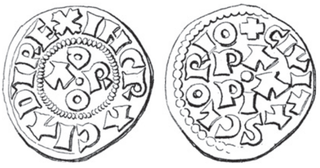Related Research Articles

The County of Loon was a county in the Holy Roman Empire, which corresponded approximately with the modern Belgian province of Limburg. It was named after the original seat of its count, Loon, which is today called Borgloon. During the middle ages the counts moved their court to a more central position in Kuringen, which today forms part of Hasselt, capital of the province.

Arduin was an Italian nobleman who was King of Italy from 1002 until 1014.
Conrad I was Duke of Swabia from 983 until 997. His appointment as duke marked the return of Conradine rule over Swabia for the first time since 948.

Boniface III, son of Tedald of Canossa and the father of Matilda of Tuscany, was the most powerful north Italian prince of his age. By inheritance he was count of Brescia, Canossa, Ferrara, Florence, Lucca, Mantua, Modena, Pisa, Pistoia, Parma, Reggio, and Verona from 1007 and, by appointment, margrave of Tuscany from 1027 until his assassination in 1052.

Adalbert was the king of Italy from 950 until 961, ruling jointly with his father, Berengar II. After their deposition, Adalbert continued to claim the Italian kingdom until his defeat in battle by the forces of Otto I in 965. Since he was the second Adalbert in his family, the Anscarids, he is sometimes numbered Adalbert II. His name is occasionally, especially in older works, shortened to Albert.
Arduin Glaber was count of Auriate from c. 935, count of Turin from c. 941/942, and Margrave of Turin from c. 950/964. He placed his dynasty, the Arduinici, on a firm foundation and established the march of Turin through conquests and royal concessions. The Chronicon Novaliciense, the chronicle of the abbey of Novalesa, is the primary source for his life.

Albert Azzo I was an Italian nobleman. He was a member of the Obertenghi family. From 1014 onward, he was margrave of Milan and count of Luni, Genoa and Tortona.
Richelida or Richilda was a member of the dynasty known to historians as the Giselbertiners. Her second husband was Boniface III of Tuscany.
Theodoric I was a nobleman in the Duchy of Saxony, and the oldest traceable member of the House of Wettin.
Arnulf II was Archbishop of Milan from 998 to 1018.

Henry II, also known as Saint Henry the Exuberant, Obl. S. B., was Holy Roman Emperor from 1014. He died without an heir in 1024, and was the last ruler of the Ottonian line. As Duke of Bavaria, appointed in 995, Henry became King of the Romans following the sudden death of his second cousin, Emperor Otto III in 1002, was made King of Italy in 1004, and crowned emperor by Pope Benedict VIII in 1014.
Lanfranc I of Bergamo was a northern Italian nobleman. He was a member of the dynasty known to historians as the Giselbertiners.
Giselbert I of Bergamo was a northern Italian nobleman.
Rotruda of Pavia was an Italian noblewoman. Rotruda was married to Giselbert I of Bergamo and later became the mistress of Hugh of Italy.
Count Giselbert of Loon or (later) Duras, was the deputy advocate (subadvocatus) of Saint Trudo’s Abbey. He was son of Otto I, Count of Duras, and his wife Oda. Giselbert was the first person to be named in contemporary documents as a count of Duras.
The County of Piacenza was a county of the Frankish kingdom of Italy. Its centre was the ancient and walled city of Piacenza at the confluence of the Trebbia and the Po, just downriver from the royal capital of Pavia. Much of the county was dominated by the Apennine Mountains. It roughly corresponds to the modern province of Piacenza.
Adela of Milan was a northern Italian noblewoman. Through her marriage to Albert Azzo I, Margrave of Milan, Adela was Margravine of Milan.
Baldrick II was bishop of Liège from 1008 to his death at Heerewaarden in what is now the Netherlands.
Willa of Spoleto was the daughter of Boniface I, duke of Spoleto. Through marriage to Hubert, Duke of Spoleto Willa became duchess of Spoleto and margravine of Tuscany.

Jörg Jarnut was a German historian who was Chair of Medieval History at the University of Paderborn from 1983 to 2007.
References
- F. Menant, ‘Les Giselbertins, comtes du comté de Bergame et comtes palatins,’ in Formazione e strutture dei ceti dominanti nel medioevo (1988), pp. 115–186.
- J. Jarnut, Bergamo 568-1098. Verfassungs-, Sozial- und Wirtschaftsgeschichte einer lombardischen Stadt im Mittelalter (Wiesbaden, 1977).
- A. Bedina, 'Giselberto,' in Dizionario Biografico degli Italiani - Volume 56 (2001)
- E. Hlawitschka, Franken, Alemannen, Bayern und Burgunder in Oberitalien, 774-962: Zum Verständnis der fränkischen Königsherrschaft in Italien (Freiburg im Breisgau, 1960), accessible online: Genealogie Mittelalter